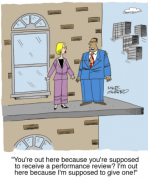We all know that the annual performance review is going by the wayside. The cumbersome process leaves managers feeling drained and employees devalued. Let’s face it, this dreaded beast of a process provided little in the way of measurable results compared with the time and effort required. Even the stalwarts who set the annual review standard, such as General Electric, are changing their approach.
There’s a new way of thinking when it comes to employee performance, and it’s a shift away from a stack ranked annual performance review to ongoing dialogue between the manager and employee. It’s a mindset shift that requires the manager to be a coach and the employee to take greater responsibility for their career and leadership development.
The challenge is that companies can’t just flip a switch to make the annual review go away. Take, for example, this mid-sized municipality in Colorado that sought to upgrade its “HR” processes. They thought that by turning off the annual review process, they would be seen as more agile, more progressive and more attractive to younger workers. The problem was that most leaders in their organization had come from a top down mindset and weren’t accustomed to providing the ongoing dialogue that employees seek and deserve. The managers just weren’t equipped with the skills or the mindset to be successful in the new environment. As a result, the rollout stalled and employees saw the effort as yet another management flavor of the month.
The Evolution
Making the transition from the traditional annual performance review process to a more agile performance process is an evolution. Here are three keys to success that must be in place.
Managers need coaching skills. This is the first and foremost foundational requirement. Leaders need to learn how to coach their team members – to be great listeners, ask good questions and help team members see what they can’t see on their own. Those same managers need to transition into being great coaches that provide development opportunities and create an environment where team members always know where they stand. They need to see coaching a a process to helping their team members be successful.
The culture has to value coachability. Coachability is both an individual mindset and a corporate value. In many ways it’s the life blood of a performance based organization. When leaders are open to coaching from their managers, peers, and direct reports, they set a tone of openness and ongoing improvement. They enable others to be vulnerable, make mistakes and constantly be in a state of learning. Team members who are high performers but not highly coachable are not and can never be “A” players. Do you want to create a great team or organization? Fill it with leaders and team members who are coachable.
The process must be supported by a measurement system. Managers who are coaches need support. That’s why we created Coachmetrix. It’s a system designed for the modern-day agile performance management process. It provides transparency with action plans and goals. It provides ongoing measurement through a pulse feedback mechanism so that the team member always knows if he or she is winning. And it provides a common platform to capture notes, discussions and resources between 1-1 coaching sessions or goal reviews. Regardless of what system you use, people need clear, succinct goals that are in line with the organizational direction. They need a system that will help measure success. And they need access to tools and resources on their mobile devices.
Everyone Wins with an Agile Approach
When an employee knows where they stand because of great coaching from their manager, everyone wins. Employees are more engaged, managers get to spend less time managing and more time leading and the organization as a whole will be more aligned and productive.
Stay tuned for more in our series on Coachability and how to transition to an agile coaching process that will support your people and organization.

